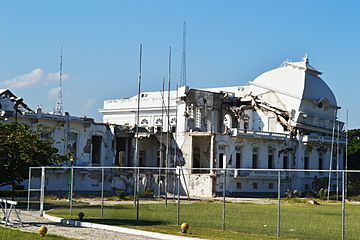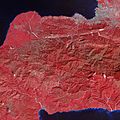2010 Haiti earthquake facts for kids

The heavily damaged National Palace after the earthquake.
|
|
| UTC time | 2010-01-12 21:53 |
|---|---|
| ISC event | 14226221 |
| USGS-ANSS | ComCat |
| Local date | 12 January 2010 |
| Local time | 16:53:10 EST |
| Magnitude | 7.0 Mw |
| Depth | 13 km (8.1 mi) |
| Epicenter | 18°28′N 72°32′W / 18.46°N 72.53°W |
| Areas affected | Haiti, Dominican Republic |
| Max. intensity | IX (Violent) |
| Peak acceleration | 0.5 g |
| Tsunami | Yes (localized) |
| Casualties | 100,000 to 316,000 deaths (the higher figure is from a government estimate widely charged with being deliberately inflated; a figure of about 160,000 is provided in a 2010 University of Michigan study; the 100,000 figure is suggested by the U.S. Geological Survey.) |
The 2010 Haiti earthquake was a very powerful earthquake that shook Haiti on January 12, 2010. It had a magnitude of 7.0 Mw, which is a measure of its strength. The earthquake's center was near Léogâne, a town very close to Port-au-Prince, Haiti's capital city. It was only about 25 kilometres (16 mi) west of the capital. The quake happened in the afternoon, at 4:53 PM local time. Haiti was already the poorest country in the western hemisphere, which made it very difficult for them to help all the people who needed it after such a big disaster.
What Happened During the Earthquake?
About three million people were affected by the earthquake. Many homes and buildings were completely destroyed. Just three days after the earthquake, officials in Haiti said that up to 200,000 people might have died. This was a much higher number than first thought. The Red Cross had first estimated a lower number of deaths, around 45,000 to 50,000.
Damage in Port-au-Prince
The earthquake caused huge damage in Port-au-Prince. Many important landmarks were badly damaged or completely destroyed. The Presidential Palace, where the president works, was destroyed. The National Assembly building, the Port-au-Prince Cathedral, and the city's main jails also collapsed. The president at the time, René Préval, survived the earthquake.
Most hospitals in the area were destroyed, which made it much harder to help injured people. The main office of the United Nations Stabilization Mission in Haiti (MINUSTAH) in Port-au-Prince also fell down. The head of the Mission, Hédi Annabi, his deputy, and the acting police chief were all killed. A representative from the United Nations (UN) called this earthquake the worst disaster the UN had ever faced. This was not just because of the damage and deaths. Roads, phone lines, and government buildings were also destroyed. This made it very hard to get organized and send help to the people who needed it most.
Images for kids
-
The Haitian government began a programme to move homeless people out of Port-au-Prince on a ferry to Port Jeremie and in hired buses to temporary camps
-
One of the first parachute air drops after the quake, 18 January
-
Helicopters transfer injured earthquake victims to hospital ship USNS Comfort off the coast of Haiti
-
The UN Development Programme employed hundreds of Haitians to clear roads and to make fuel pellets in a cash-for-work scheme
-
A US mobile air traffic control tower is moved to Haiti by an Antonov An-124 Ruslan
See also
 In Spanish: Terremoto de Haití de 2010 para niños
In Spanish: Terremoto de Haití de 2010 para niños



























